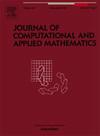Optical solitons, dynamics of bifurcation, and chaos in the generalized integrable (2+1)-dimensional nonlinear conformable Schrödinger equations using a new Kudryashov technique
IF 2.1
2区 数学
Q1 MATHEMATICS, APPLIED
Journal of Computational and Applied Mathematics
Pub Date : 2024-09-28
DOI:10.1016/j.cam.2024.116298
引用次数: 0
Abstract
In the present paper, the new Kudryashov approach is utilized to construct several novel optical soliton solutions for the generalized integrable (2 + 1)-dimensional nonlinear Schrödinger system with conformable derivative. Additionally, the dynamics of bifurcation behavior and chaos analysis in this system are investigated. We applied bifurcation and chaos theories to enhance our understanding of the planar dynamical system derived from the current model while we obtained and illustrated the chaotic solutions for the perturbed dynamical system using graphs. The study yields a class of new optical soliton solutions, including bell-shaped, wave, dark, dark-bright, dark, multi-dark, and singular soliton solutions. Three-dimensional, two-dimensional, and contour plots are presented to visually demonstrate the physical implications and dynamic characteristics of the current conformable equation system. Further, an analysis is discussed on how the conformable derivative parameter and the parameter of time impact the present optical solutions, demonstrating the system’s importance. It is believed that the solutions analyzed in this study are entirely new and have not been previously reported. These discoveries have the potential to significantly enhance our understanding of nonlinear physical phenomena, especially in nonlinear optics and traffic signaling effects with optical dromion transmission.
利用新的库德里亚索夫技术研究广义可积分 (2+1)- 维非线性共形薛定谔方程中的光学孤子、分岔动力学和混沌
本文利用新的 Kudryashov 方法,为具有保形导数的广义可积分 (2 + 1) 维非线性薛定谔系统构建了几种新的光孤子解。此外,还研究了该系统的分岔行为动力学和混沌分析。我们应用分岔和混沌理论加深了对当前模型衍生出的平面动力系统的理解,同时利用图形获得并说明了扰动动力系统的混沌解。研究得出了一类新的光学孤子解,包括钟形、波形、暗形、暗-明形、暗形、多暗形和奇异孤子解。研究还给出了三维、二维和等值线图,直观地展示了当前共形方程系统的物理意义和动态特性。此外,还讨论了保形导数参数和时间参数如何影响当前光学解法的分析,证明了该系统的重要性。据信,本研究分析的解决方案是全新的,以前从未报道过。这些发现有可能极大地提高我们对非线性物理现象的理解,尤其是在非线性光学和光学多米子传输的交通信号效应方面。
本文章由计算机程序翻译,如有差异,请以英文原文为准。
求助全文
约1分钟内获得全文
求助全文
来源期刊
CiteScore
5.40
自引率
4.20%
发文量
437
审稿时长
3.0 months
期刊介绍:
The Journal of Computational and Applied Mathematics publishes original papers of high scientific value in all areas of computational and applied mathematics. The main interest of the Journal is in papers that describe and analyze new computational techniques for solving scientific or engineering problems. Also the improved analysis, including the effectiveness and applicability, of existing methods and algorithms is of importance. The computational efficiency (e.g. the convergence, stability, accuracy, ...) should be proved and illustrated by nontrivial numerical examples. Papers describing only variants of existing methods, without adding significant new computational properties are not of interest.
The audience consists of: applied mathematicians, numerical analysts, computational scientists and engineers.

 求助内容:
求助内容: 应助结果提醒方式:
应助结果提醒方式:


